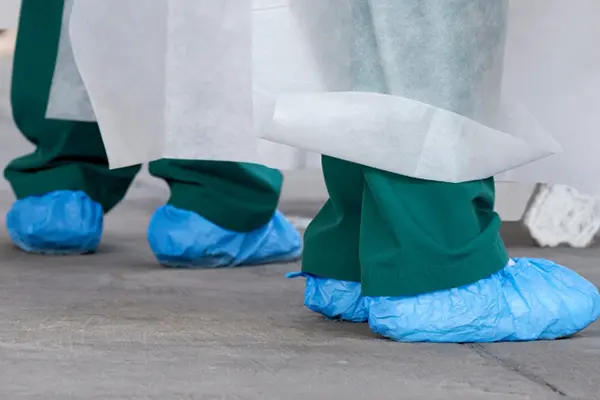In medical settings, hygiene and safety are of paramount importance. Doctors and healthcare professionals take numerous precautions to maintain sterile environments and minimize the risk of infection. Among these precautions, wearing protective shoe covers is a simple but highly effective measure. While often overlooked, shoe covers play a critical role in maintaining cleanliness and ensuring the safety of both medical staff and patients. This article explores the reasons why doctors wear protective shoe covers and their significance in healthcare environments.
1. Preventing Contamination
One of the primary reasons doctors wear protective shoe covers is to prevent contamination. Shoes are a significant source of dirt, dust, and pathogens, as they come into contact with various surfaces throughout the day. When doctors enter sterile areas, such as operating rooms or intensive care units, any contaminants carried on their shoes can pose serious risks.
- Maintaining Sterile Environments: Protective shoe covers act as a barrier, preventing outside contaminants from being introduced into clean and sterile zones. This is crucial during surgeries, where even the smallest amount of dirt or bacteria can lead to infections or complications for the patient.
- Reducing Cross-Contamination: Doctors and healthcare workers move between different areas in a hospital. Shoe covers help limit the spread of germs and bacteria from one area to another, ensuring that contaminants from less-clean areas don’t reach sterile environments.

2. Protecting Patients from Infections
In hospitals and clinics, patients, especially those with weakened immune systems, are highly susceptible to infections. Shoe covers help protect patients by reducing the presence of pathogens in their immediate environment.
- Safeguarding Vulnerable Patients: Protective shoe covers are particularly important in units with immunocompromised patients, such as neonatal intensive care units (NICUs), oncology wards, or transplant units. These patients are more prone to infections that could be carried in on footwear.
- Preventing Hospital-Acquired Infections (HAIs): HAIs are a significant concern in healthcare settings. Wearing shoe covers minimizes the risk of these infections by ensuring that floors and patient areas remain as clean as possible.
3. Protecting Healthcare Workers
In addition to protecting patients, shoe covers also safeguard doctors and healthcare workers themselves. Hospitals often deal with hazardous substances, bodily fluids, and infectious diseases, which can pose risks to medical staff.
- Shielding Against Hazardous Materials: Protective shoe covers provide a physical barrier against spills, splashes, and other contaminants that might land on footwear. This protection is especially important during procedures involving blood, chemicals, or infectious materials.
- Reducing Personal Contamination: Shoe covers ensure that doctors don’t inadvertently carry contaminants home on their shoes, safeguarding their families and communities.
4. Maintaining Cleanliness in Medical Facilities
Hospitals and clinics require high standards of cleanliness, not just in sterile areas but throughout the facility. Shoe covers contribute to this cleanliness by limiting the amount of dirt and debris tracked indoors.
- Reducing Cleaning Efforts: By containing dirt and contaminants, shoe covers reduce the frequency and intensity of cleaning required, saving time and resources for the hospital’s maintenance staff.
- Improving Aesthetics: Clean floors and hallways contribute to a more professional and reassuring environment for patients and visitors. Shoe covers help maintain these high standards.
5. Specialized Use in Certain Situations
In addition to general use, protective shoe covers are also employed in specific medical scenarios:
- In Operating Rooms: Sterile conditions are critical in surgeries. Shoe covers prevent any external contaminants from being introduced into the operating room.
- During Epidemics or Pandemics: During outbreaks of infectious diseases, such as COVID-19, shoe covers are often part of the personal protective equipment (PPE) worn by healthcare workers to limit exposure to the virus.
- In Laboratories: Doctors and researchers working in labs often wear shoe covers to prevent contamination of sensitive experiments or samples.
6. Eco-Friendly and Disposable Options
Many modern shoe covers are designed to be disposable, ensuring they can be discarded after a single use, thereby eliminating the risk of contamination from one patient to another. Additionally, some manufacturers now produce eco-friendly shoe covers made from biodegradable materials, aligning with hospitals’ efforts to reduce environmental impact.
Conclusion
Protective shoe covers may seem like a small and simple item, but their role in healthcare settings is profound. They help maintain sterile environments, protect patients from infections, safeguard healthcare workers from hazardous materials, and contribute to overall cleanliness. By minimizing the risk of contamination and infection, shoe covers support the broader goal of delivering safe and effective medical care. Whether in operating rooms, patient wards, or laboratories, shoe covers remain an essential component of the healthcare profession’s commitment to hygiene and safety.
Post time: Dec-03-2024





